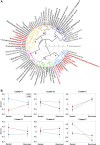Metabolomics reveals mouse plasma metabolite responses to acute exercise and effects of disrupting AMPK-glycogen interactions
- PMID: 36090035
- PMCID: PMC9449498
- DOI: 10.3389/fmolb.2022.957549
Metabolomics reveals mouse plasma metabolite responses to acute exercise and effects of disrupting AMPK-glycogen interactions
Abstract
Introduction: The AMP-activated protein kinase (AMPK) is a master regulator of energy homeostasis that becomes activated by exercise and binds glycogen, an important energy store required to meet exercise-induced energy demands. Disruption of AMPK-glycogen interactions in mice reduces exercise capacity and impairs whole-body metabolism. However, the mechanisms underlying these phenotypic effects at rest and following exercise are unknown. Furthermore, the plasma metabolite responses to an acute exercise challenge in mice remain largely uncharacterized. Methods: Plasma samples were collected from wild type (WT) and AMPK double knock-in (DKI) mice with disrupted AMPK-glycogen binding at rest and following 30-min submaximal treadmill running. An untargeted metabolomics approach was utilized to determine the breadth of plasma metabolite changes occurring in response to acute exercise and the effects of disrupting AMPK-glycogen binding. Results: Relative to WT mice, DKI mice had reduced maximal running speed (p < 0.0001) concomitant with increased body mass (p < 0.01) and adiposity (p < 0.001). A total of 83 plasma metabolites were identified/annotated, with 17 metabolites significantly different (p < 0.05; FDR<0.1) in exercised (↑6; ↓11) versus rested mice, including amino acids, acylcarnitines and steroid hormones. Pantothenic acid was reduced in DKI mice versus WT. Distinct plasma metabolite profiles were observed between the rest and exercise conditions and between WT and DKI mice at rest, while metabolite profiles of both genotypes converged following exercise. These differences in metabolite profiles were primarily explained by exercise-associated increases in acylcarnitines and steroid hormones as well as decreases in amino acids and derivatives following exercise. DKI plasma showed greater decreases in amino acids following exercise versus WT. Conclusion: This is the first study to map mouse plasma metabolomic changes following a bout of acute exercise in WT mice and the effects of disrupting AMPK-glycogen interactions in DKI mice. Untargeted metabolomics revealed alterations in metabolite profiles between rested and exercised mice in both genotypes, and between genotypes at rest. This study has uncovered known and previously unreported plasma metabolite responses to acute exercise in WT mice, as well as greater decreases in amino acids following exercise in DKI plasma. Reduced pantothenic acid levels may contribute to differences in fuel utilization in DKI mice.
Keywords: AMP-activated protein kinase; acylcarnitines; amino acids; exercise metabolism; glycogen; metabolomics; pantothenic acid; plasma metabolite.
Copyright © 2022 Belhaj, Lawler, Hawley, Broadhurst, Hoffman and Reinke.
Conflict of interest statement
The authors declare that the research was conducted in the absence of any commercial or financial relationships that could be construed as a potential conflict of interest.
Figures



Similar articles
-
Disrupting AMPK-Glycogen Binding in Mice Increases Carbohydrate Utilization and Reduces Exercise Capacity.Front Physiol. 2022 Mar 22;13:859246. doi: 10.3389/fphys.2022.859246. eCollection 2022. Front Physiol. 2022. PMID: 35392375 Free PMC article.
-
Mice with Whole-Body Disruption of AMPK-Glycogen Binding Have Increased Adiposity, Reduced Fat Oxidation and Altered Tissue Glycogen Dynamics.Int J Mol Sci. 2021 Sep 5;22(17):9616. doi: 10.3390/ijms22179616. Int J Mol Sci. 2021. PMID: 34502525 Free PMC article.
-
Genetic loss of AMPK-glycogen binding destabilises AMPK and disrupts metabolism.Mol Metab. 2020 Nov;41:101048. doi: 10.1016/j.molmet.2020.101048. Epub 2020 Jun 29. Mol Metab. 2020. PMID: 32610071 Free PMC article.
-
Interactive Roles for AMPK and Glycogen from Cellular Energy Sensing to Exercise Metabolism.Int J Mol Sci. 2018 Oct 26;19(11):3344. doi: 10.3390/ijms19113344. Int J Mol Sci. 2018. PMID: 30373152 Free PMC article. Review.
-
Energy sensing by the AMP-activated protein kinase and its effects on muscle metabolism.Proc Nutr Soc. 2011 Feb;70(1):92-9. doi: 10.1017/S0029665110003915. Epub 2010 Nov 11. Proc Nutr Soc. 2011. PMID: 21067629 Review.
Cited by
-
Exercise improves systemic metabolism in a monocrotaline model of pulmonary hypertension.Sports Med Health Sci. 2024 Mar 8;7(1):37-47. doi: 10.1016/j.smhs.2024.03.001. eCollection 2025 Jan. Sports Med Health Sci. 2024. PMID: 39649790 Free PMC article.
-
Age-related changes of skeletal muscle metabolic response to contraction are also sex-dependent.J Physiol. 2025 Jan;603(1):69-86. doi: 10.1113/JP285124. Epub 2023 Sep 23. J Physiol. 2025. PMID: 37742081 Free PMC article.
References
-
- Bihlmeyer N. A., Kwee L. C., Clish C. B., Deik A. A., Gerszten R. E., Pagidipati N. J., et al. (2021). Metabolomic profiling identifies complex lipid species and amino acid analogues associated with response to weight loss interventions. PLoS One 16 (5), e0240764. 10.1371/journal.pone.0240764 - DOI - PMC - PubMed
-
- Broadhurst D., Goodacre R., Reinke S. N., Kuligowski J., Wilson I. D., Lewis M. R., et al. (2018). Guidelines and considerations for the use of system suitability and quality control samples in mass spectrometry assays applied in untargeted clinical metabolomic studies. Metabolomics 14 (6), 72. 10.1007/s11306-018-1367-3 - DOI - PMC - PubMed
LinkOut - more resources
Full Text Sources

